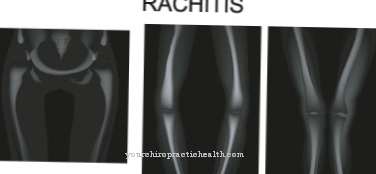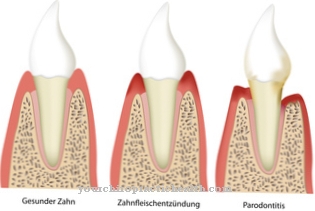The symptoms of a Ulnar paralysis differs from person to person according to the cause of the disease. With early, competent therapy, paralysis regression is possible in various cases.
What is ulnar paralysis?
In the Ulnar paralysis (in medicine also as Ulnar palsy It is a damage that affects the ulnar nerve (a nerve in the plexus of the arm). Since the ulnar nerve supplies various muscles in the arm and hand areas, ulnar paralysis usually manifests itself in functional failures of the corresponding muscles.
Symptoms of ulnar paralysis differ depending on the location of the corresponding nerve damage. A common consequence of ulnar paralysis is the development of a so-called claw or Claw hand; This manifests itself in the affected person in a splayed thumb and a metacarpophalangeal joint that remains stretched even when the fingers are bent.
Other possible symptoms of ulnar paralysis include numbness of the little fingers and balls of the fingers. In humans, ulnar palsy is the most common damage to nerves that run outside the brain and spinal cord.
causes
Behind one Ulnar paralysis various causes can hide; Especially in ulnar nerve lesions that occur on the upper arm, the paralysis is often due to trauma (external violence).
In addition, fractures (broken bones) in the arm area can also cause ulnar paralysis. In some cases, ulnar paralysis occurs as a result of surgical treatment of injuries to the elbow. Long-term pressure on the ulnar nerve, particularly in the elbow area, can promote ulnar palsy; Such a pressure load can take place, for example, in the context of occupational activities in which a frequent leaning on the elbow takes place.
Cycling can also put pressure on the ulnar nerve; for example by using triathlon handlebars. Last but not least, the fact that people are bedridden often results in ulnar paralysis due to pressure loads.
Symptoms, ailments & signs
Symptoms mainly occur in the form of muscle paralysis and the loss of motor skills. These relate to the elbow and wrist. The so-called claw hand is typical. Medical professionals use this term to describe the condition in which the metacarpophalangeal joints are hyperextended and the terminal joints are partially flexed.
Many patients complain that they can no longer move their little finger and ring finger. The thumb usually remains splayed out. This means that the wrist can only be used to a limited extent. Sometimes other muscle groups can compensate for the neural limitations, which is why those affected are not always aware of the disease. It is not uncommon for this to result in an elbow dislocation.
Ulnar paralysis is not only characterized by a recognizable deformity. Those affected regularly report numbness. The sensation on the fingers is significantly reduced. The loss of function of the muscles has a significant impact on everyday life. Simple activities such as writing or operating electrical devices are only possible with great effort.
Sick people may need help with small tasks. If the neural disease is not treated in time, it can persist permanently. The functionality of one hand is then usually clearly impaired.
Diagnosis & course
The diagnosis of a Ulnar paralysis usually begins with a conversation with the patient, during which the treating doctor asks, among other things, the medical history and individual symptoms of a person affected.
In a subsequent neurological examination, various so-called ulnar function tests can provide information about the presence of ulnar paralysis; for example, the ability to bend the hand and fingers against various resistances is tested. The nerve conduction velocity of the ulnar nerve can be determined using a so-called electromyography.
Finally, it can still be ruled out that the functional impairment of a patient is based on a problem other than that of ulnar paralysis. The course of ulnar paralysis depends, among other things, on its cause and the corresponding treatment steps. With suitable therapy, ulnar paralysis, for example, can often regress due to pressure.
Complications
With ulnar paralysis there are serious complaints and complications. These have a very negative effect on the quality of life of the person affected and can significantly reduce it. With ulnar paralysis, many sufferers are dependent on the help of other people in their everyday life and can no longer easily carry out many everyday things.
The patients suffer from severe deficits in motor and cognitive abilities. This also leads to movement restrictions and severe restrictions in everyday life. Numbness and other disorders of sensitivity appear in the fingers. The hand itself can no longer be moved either, so that a claw hand develops. Elbow dislocation can also occur.
Especially in children, ulnar paralysis can lead to severe restrictions and delays in development, so that symptoms and complications can also arise in adulthood. The treatment of ulnar paralysis always depends on the underlying disease.
No prediction can be made about the course of the disease. Those affected may be dependent on surgical interventions so that the symptoms can be alleviated. In most cases, the patient's life expectancy is not negatively affected by the ulnar paralysis.
When should you go to the doctor?
In the case of ulnar paralysis, the person concerned is always dependent on a visit to a doctor. This disease cannot self-heal, so an examination and subsequent treatment by a doctor must always be carried out. The earlier a doctor is consulted, the better the further course of the disease is usually. As soon as the first symptoms and signs appear, the person affected should therefore consult a doctor. A doctor should be contacted if the patient suffers from severe paralysis in the muscles.
Above all, the muscles in the hands are affected, so that the ulnar paralysis also restricts the person's everyday life. Furthermore, severe pain in the hands can indicate this disease and should also be examined by a doctor. Numbness in the hands can also indicate ulnar paralysis and must be examined by a doctor. The disease can be diagnosed by a general practitioner or by an orthopedic surgeon. Further treatment is then carried out by a specialist.
Treatment & Therapy
The therapy one Ulnar paralysis depends on factors such as causes of paralysis and individual symptoms of a patient.
Basically, both conservative (non-surgical) and surgical procedures can be considered for the treatment of ulnar paralysis. In the context of ulnar paralysis caused by pressure loads, a conservative treatment method consists, for example, of relieving the pressure and padding the affected arm. During the night, the arm affected by ulnar paralysis can also be provided with a splint in order to prevent corresponding flexion movements.
If ulnar paralysis caused by pressure cannot be successfully treated conservatively, the attending physician will often consider surgical intervention. Paralysis of the ulnar nerve due to injuries in the elbow area is also often treated surgically.
For example, the ulnar nerve can be relocated as part of an appropriate operation. So-called neurolysis is also possible for the surgical treatment of ulnar paralysis: Any constrictions of the ulnar nerve (such as adhesions from scar tissue) are removed in order to relieve the nerve. Surgical measures to treat ulnar paralysis usually require the affected arm to be immobilized for several weeks.
You can find your medication here
➔ Medicines for paresthesia and circulatory disordersprevention
One Ulnar paralysis Long-term pressure loads can be prevented, for example, by protecting the arm; As far as possible, this can be done in the context of occupational and / or sport-related pressure on the arm, for example by using appropriate padding. Trauma that can lead to ulnar paralysis can only be prevented to a limited extent.
Aftercare
If the ulnar paralysis was treated surgically, in most cases the affected upper arm is temporarily immobilized with a cast. This procedure gives the extensive and deep wound the opportunity to regenerate. Complete immobilization of the arm in a cast is only required if the ulnar nerve has undergone open surgery.
If, on the other hand, the surgical procedure was carried out in a minimally invasive manner with an endoscope, the entire arm is given a pressure bandage after the operation. The patient is allowed to move his elbow gently. The skin staples or sutures applied during an operation can be removed after about ten to 14 days. The prerequisite, however, is that the wound heals smoothly.
Often a small drain is placed at the end of the procedure. It ensures that the blood and the wound fluid flow away unhindered. The drain can be removed after one to three days. Usually the immobilization of the affected arm lasts two to three weeks. This is followed by physiotherapy, during which the arm is accustomed to the usual loads again over a period of several weeks.
However, caution is advised with the physiotherapeutic exercises, because swelling and pain can occur if the procedure is too rapid. This can even endanger the outcome of the operation. It is also important to avoid mechanical loads and excessive pressure.
You can do that yourself
Depending on the cause and therapy, various self-help measures are available to promote the healing of ulnar paralysis. Conservative therapy at home can be supported by gentle exercise and good care of the affected limbs.
If a splint has been placed, it must be worn according to the doctor's instructions. Patients are best to speak to a physical therapist about exercises that can be done at home. The diet should be adjusted and should be given plenty of minerals and vitamins during the illness. In addition, general measures such as adequate bed rest and avoiding stress apply. The affected hand should only gradually be loaded again. Surgical treatment can be assisted by taking good care of the scar. The affected hand must not be subjected to any further stresses in order to prevent the scar from opening and paralysis or injury from occurring again.
Affected people should rest for at least four to six weeks. Exhausting physical work may not be carried out during this period. As a rule, the health insurance company pays for the incapacity for work. If you suspect ulnar paralysis, the health insurance company should be involved at an early stage.


.jpg)


.jpg)





















